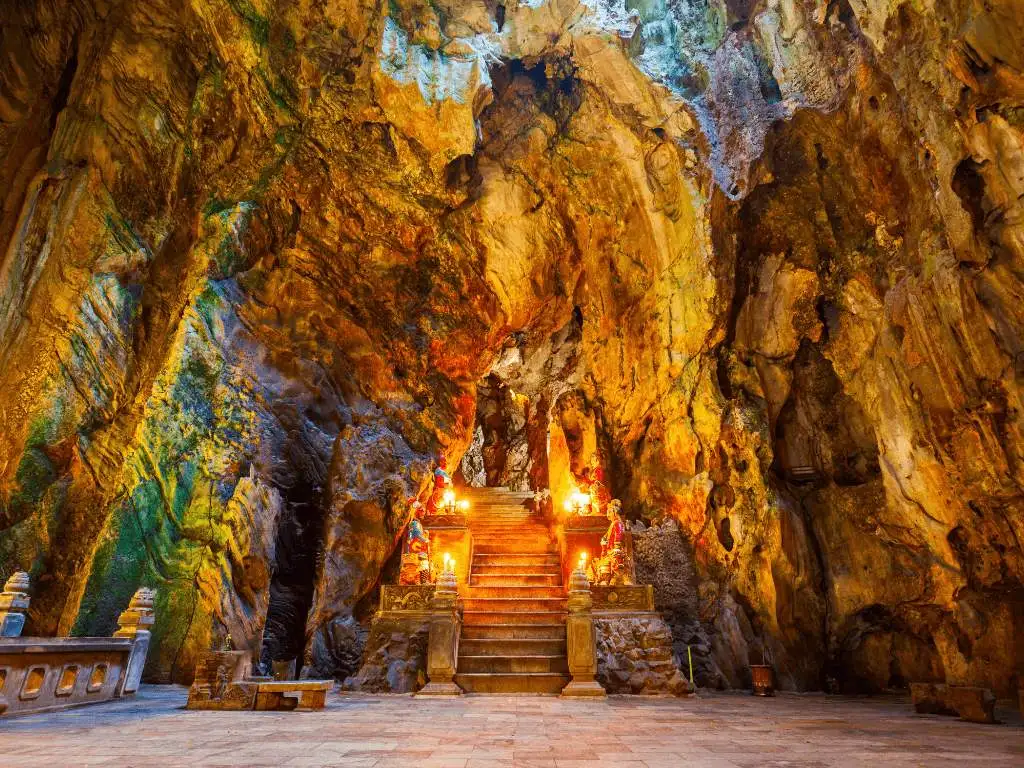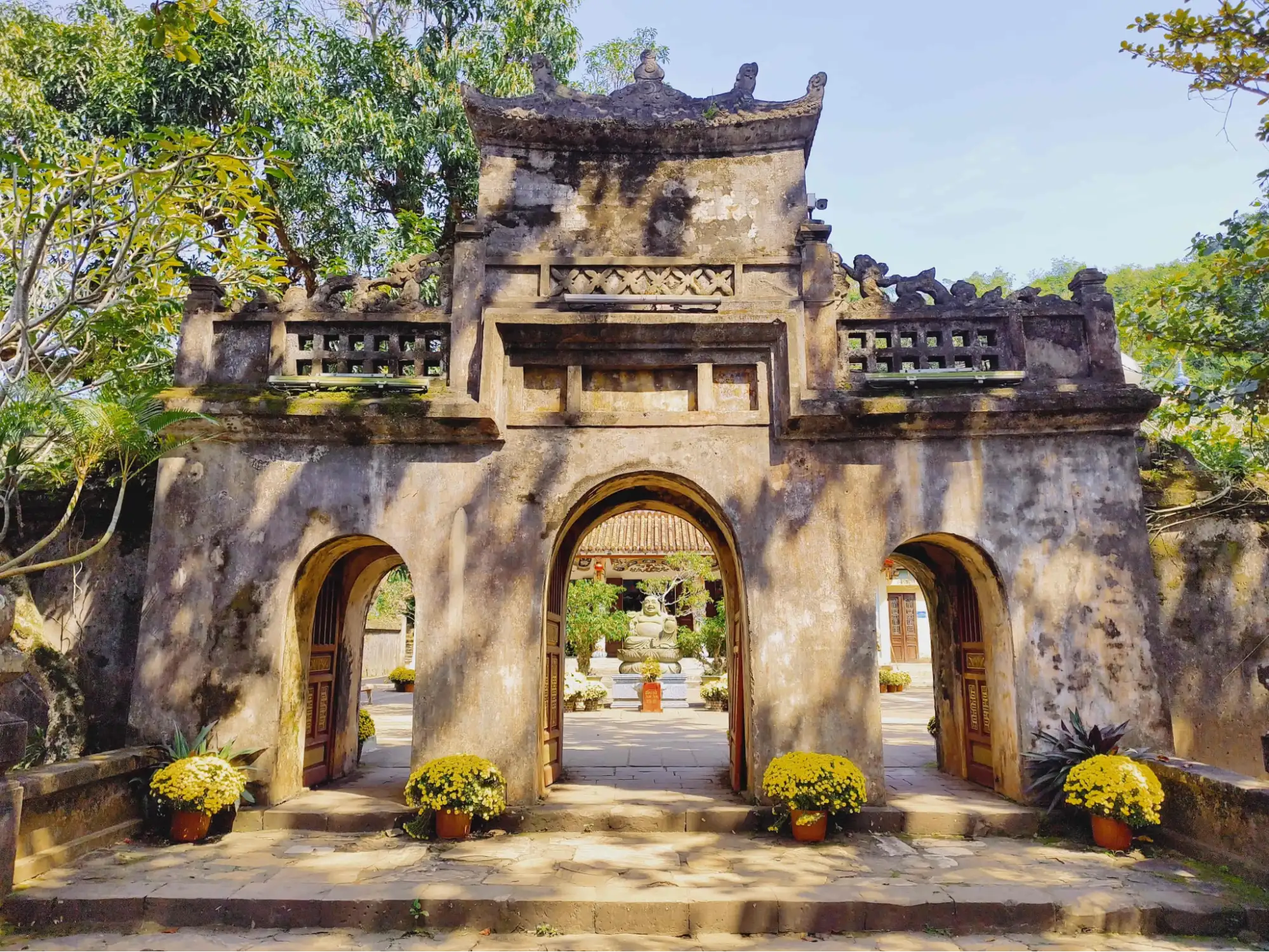Marble Mountains history: Unveiling Vietnam Heritage
Marble Mountains history is a captivating tale that stretches back through centuries, offering a unique glimpse into the cultural and spiritual heritage of Vietnam. Located just 8 km south of Da Nang’s city center, these five limestone peaks have long been revered as sacred sites. From the Champa Kingdom to the modern era, the Marble Mountains have played an integral role in shaping the region’s spiritual landscape.
Introduction to the Marble Mountains
The Marble Mountains, one of the most famous landmarks in Da Nang, are a cluster of limestone hills located to the south of the city, about 8 kilometers from the city center. The complex consists of five main mountains: Thuy Son, Kim Son, Moc Son, Hoa Son, and Tho Son, each named after one of the five elements in Eastern philosophy, symbolizing the harmony between nature and the universe according to the principles of yin and yang.
Among the five peaks, Thuy Son (Water Mountain) is the largest and most visited. It is home to a network of ancient pagodas, mysterious caves, and viewpoints offering panoramic views of the sea and countryside. Each mountain has its own unique character. Kim Son (Metal Mountain) is famous for its Buddhist shrines. Moc Son (Wood Mountain) stands out for its solitary stone structures. Hoa Son (Fire Mountain) features twin peaks and historic temples. Tho Son (Earth Mountain) is known for its ancient tunnels and smaller, hidden pagodas.

Beyond their natural beauty, the Marble Mountains hold deep cultural and spiritual significance. For centuries, these peaks have been revered as sacred places. They house many Buddhist sanctuaries and Hindu relics from the Champa Kingdom. Intricate caves served both as places of worship and shelters during Vietnam’s tumultuous history.
Highlights include Linh Ung Pagoda, a place of pilgrimage topped by a towering statue of the Goddess of Mercy. Tam Thai Pagoda, dating back to the 17th century, is another must-visit temple. Inside the caves, visitors can find ancient stone altars, statues, and inscriptions that reveal the rich layers of history hidden within the mountains.
Today, Ngu Hanh Son is more than a spiritual destination. It is also a powerful symbol of Da Nang’s rich heritage. For visitors seeking more than beautiful scenery, a journey to the Marble Mountains offers an unforgettable blend of natural wonders, religious devotion, and centuries-old history.
Read more: Guide on how to get to the Marble Mountains from Da Nang
Marble mountains history
The Marble Mountains are not only a famous destination for their stunning landscapes but also a place that holds deep historical significance in Vietnam. From ancient times to the modern era, this mountain range has witnessed and been associated with many important events, beliefs, and cultural practices.
Each historical period has contributed to shaping the current identity of the Marble Mountains, where every peak and cave tells its own unique story. Let’s explore the history of the Marble Mountains through different periods, from the Champa Kingdom to Dai Viet, and into the 20th century, to better understand the cultural and religious value of this heritage site.
During the Champa Period (10th–15th centuries)
The early history of the Marble Mountains is deeply tied to the Champa Kingdom, which flourished in Central Vietnam between the 10th and 15th centuries. During this time, the area of Ngu Hanh Son was considered a sacred site by the Cham people, who practiced Hinduism and later embraced elements of Buddhism. They believed that the mountains were the dwelling place of powerful spirits, making them an important center for religious worship.
Archaeological findings reveal that the Cham people built shrines and temples within and around the caves of the Marble Mountains. Traces of Hindu deities, such as carvings of Shiva and other divine figures, have been discovered, showing the influence of Indian culture on the Cham civilization. The natural caves served as both places of worship and meditation, offering a serene and mystical setting for spiritual practices.

One of the most significant caves, Huyen Khong Cave, is believed to have been used for religious ceremonies by the Cham centuries ago. Over time, these sacred spaces were expanded and incorporated into later Buddhist traditions, but the Cham legacy remains a vital foundation of the Marble Mountains’ spiritual identity.
Today, visitors can still feel the ancient atmosphere of the Champa era when they explore the hidden corners of the mountains. The blend of natural beauty and historical spirituality makes the Marble Mountains a unique living museum of Vietnam’s layered cultural past.
During the Dai Viet period (16th–19th centuries)
From the 16th to the 19th centuries, during the Dai Viet period, the Marble Mountains experienced a new phase of cultural and spiritual development. Vietnamese settlers expanded southward and brought strong Buddhist traditions with them. They transformed Ngu Hanh Son into an important center for religious worship and meditation.
Many pagodas and temples rose during this time. Among them, Tam Thai Pagoda, built in 1630 under the reign of King Le Than Tong, stands out as one of the oldest and most revered. Monks and craftsmen placed these sacred sites carefully within caves and atop the mountains, blending religious architecture with the natural landscape.

In 1825, Emperor Minh Mang of the Nguyen Dynasty gave the mountains their official name, “Ngu Hanh Son” – meaning “Five element mountains.” He chose this name based on Eastern philosophy, where Metal, Wood, Water, Fire, and Earth symbolize the balance of nature and the universe. This naming reflected both the physical character of the mountains and their spiritual meaning in Vietnamese culture.
During this period, the Marble Mountains attracted scholars, monks, and royalty. They traveled here seeking solitude, inspiration, and spiritual enlightenment. Poets and thinkers carved ancient verses and inscriptions into the cliffs and cave walls, leaving behind a legacy of art and philosophy.
By the end of the Dai Viet period, Ngu Hanh Son had earned its reputation as one of Central Vietnam’s most sacred and celebrated sites. The cultural and religious foundations built during these centuries continue to define the spirit of the Marble Mountains today.
After 20th century
After the 20th century, the Marble Mountains continued to play an important role in Vietnam’s spiritual and historical life. During the French colonial period and the subsequent wars, the mountains were not only a sacred place but also a refuge for resistance forces. The natural caves and tunnels within the mountains provided safe shelter, protecting both the local people and soldiers.
After the wars, the Marble Mountains were gradually restored and became a popular destination for both domestic and international visitors. Ancient temples and shrines were repaired and preserved. The government also invested in developing the area with walking paths and conservation projects, making it a more accessible spiritual site while maintaining its cultural value.

Today, the Marble Mountains are not only famous for their stunning landscapes but also for preserving the history, culture, and spirituality of the Vietnamese people. Visitors can explore sacred caves like Huyen Khong and Am Phu, or admire historical architecture such as Linh Ung Pagoda and Tam Thai Pagoda, experiencing the beautiful fusion of nature, spirituality, and history.
Read more: Is Marble Mountain worth visiting? Check Vietnam’s heritage
The Marble Mountains history is an essential chapter in understanding Da Nang’s cultural and historical development. These mountains not only offer breathtaking views and natural beauty but also stand as a symbol of Vietnam’s enduring spiritual and historical journey. Marble Mountains also sit near Hoi An, a town rich in historical significance that you’ll find fascinating to explore. After a day of exploration, visitors can unwind and rejuvenate at Bliss Beach Resort & Wellness, offering a perfect blend of relaxation and wellness near Binh Minh beach.








